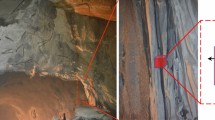Abstract
Three types of rock specimens, three-point bending specimen, anti-symmetric four-point bending specimen and direct shearing specimen, were used to achieve Mode I, Mode II and mixed mode I–II fracture, respectively. Microscopic characteristics of the three fracture modes of brittle rock were studied by SEM technique in order to analyze fracture behaviors and better understand fracture mechanisms of different fracture modes of brittle rock. Test results show that the microscopic characteristics of different fracture modes correspond to different fracture mechanisms. The surface of Mode I fracture has a great number of sparse and steep slip-steps with few tearing ridges and shows strong brittleness. In the surface of Mode II fracture there exist many tearing ridges and densely distributed parallel slip-steps and it is attributed to the action of shear stress. The co-action of tensile and shear stresses results in brittle cleavage planes mixed with streamline patterns and tearing ridges in the surface of mixed mode I–II fracture. The measured Mode II fracture toughness K II C and mixed mode I–II fracture toughness K mC are larger than Mode I fracture toughness K I C · K II C is about 3.5 times K I C, and KmC is about 1.2 times K I C.
Similar content being viewed by others
References
Outhterlong F. Suggested methods for determining the fracture toughness of rock[J]. Int J Rock Mech Min Sci & Geomech Abstr, 1988, 25(2): 71–96.
Fowell R J. Suggested methods for determining mode I fracture toughness using cracked chevron notched Brazilian disc specimens[J]. Int J Rock Mech Min Sci & Geomech Abstr, 1995, 32(1): 57–64.
Carpinteri A, Ferrara G, Melchiorri G. Single edge notched specimen subjected to four point shear: an experimental investigation[A]. Fracture of Concrete and Rock: Recent Developments[C]. Shah S P, Swartz S E, Barr B. USA, 1989. 605–614.
Biolzi L. Mixed mode fracture in concrete beams[J]. Engineering Fracture Mechanics, 1990, 35(1/2/3): 187–193.
WANG Gui-yao, SUN Zong-qi, XU Ji-chen. Rock fracture under pure shear loading[J]. The Chinese Journal of Nonferrous Metals (in Chinese), 1996, 6(3): 17–21.
RAO Qiu-hua. Pure shear fracture of brittle rock, a theoretical and laboratory study[D]. Sweden: Lulea University of Technology, 1999. 54–77.
YU Xiao-zhong, QIAO Chang-xin, ZHOU Qun-li. Fracture mechanics of rock and concrete (in Chinese) [M]. Changsha: Central South University of Technology Press, 1991. 488–489.
Fett T. Stress intensity factors for edge subjected to mixed mode four-point bending[J]. Theoretical and Applied Fracture Mechanics, 1991, 15, 99–104.
Murakami Y. Stress intensity factors handbook [M]. New York: Pergamon press, 1981, 1223.
Erdogan F, Shi G C. On the crack extension in plate under plane loading and transverse shear[J]. J Basic Eng, 1963, 85(4): 519–527.
Author information
Authors and Affiliations
Additional information
Foundation item: The National Natural Science Foundation of China (No. 49672164)
Biography of the first author: RAO Qiu-hua, doctor of engineering, born in July 1965, majoring in rock mechanics.
Rights and permissions
About this article
Cite this article
Rao, Qh., Sun, Zq., Wang, Gy. et al. Microscopic characteristics of different fracture modes of brittle rock. J Cent. South Univ. Technol. 8, 175–179 (2001). https://doi.org/10.1007/s11771-001-0049-9
Received:
Issue Date:
DOI: https://doi.org/10.1007/s11771-001-0049-9




